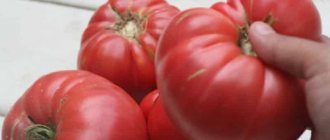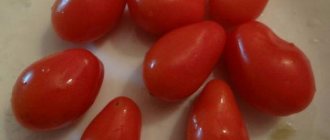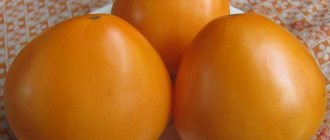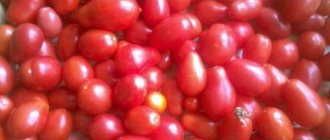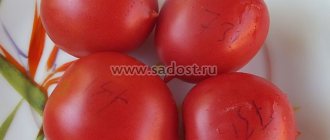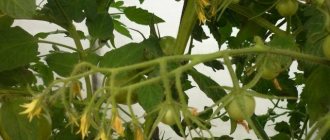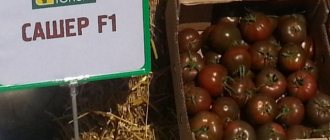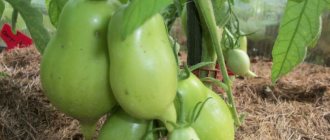What does an Ashdod f1 tomato look like: reviews and growing features
Gone are the days when in Europe at first they knew nothing about tomatoes, and then learned to grow them not for decorative purposes, but for food consumption. Today, any gardener must make his choice from a huge number of varieties and hybrids of this popular crop. Perhaps someone will like the Ashdod f tomato, and reviews about it will help to get first-hand information.
Tomato “Ashdod F 1”, description
The Ashdod tomato hybrid is a brand of the Semko agricultural company. The company, being the originator of the variety, has been offering consumers the seeds of these early tomatoes with a dark, almost black color since 2014. The hybrid was obtained for cultivation in greenhouses, but can be used in film shelters and in open ground.
The plant is characterized by unlimited shoot growth. The shoots are well leafy. Internodes are shortened. The first flower brush is laid over the seventh - ninth leaf. The next brush is formed through three sheets. The fruits of the “Ashdod” hybrid ripen 85–90 days after the appearance of the bulk of the shoots.
Ripe fruits are dark brown in color. When fully ripe, in good light and high temperature, they become red-brown. The pulp of fully ripe tomatoes is dark cherry in color.
A special feature of the fruit is its high content of the pigment lycopene. The average fruit weight is from 130 to 170 grams. The shape is round. According to reviews, the Ashdod f1 tomato, thanks to its dense and durable skin, can withstand transportation well and retains its presentation well.
Also the advantages of the variety are:
- resistance to verticillium wilt
- resistance to tomato mosaic virus
- excellent fruit set at high temperatures
- good taste
- high, up to 18 kg per sq. m., yield
A table variety, grown mainly for fresh consumption.
Growing tomato seedlings tomato Ashdod f1
Taking into account the early ripeness of the hybrid, sowing seeds for seedlings should be done in the last ten days of March - the first two weeks of April. Since at this time the length of the day increases. The seedlings do not need additional lighting. The consumer should know that there are no more than 10 seeds of this hybrid in one bag from the Semko company for amateur vegetable growing.
They can be planted immediately in individual pots with a capacity of 150 – 200 ml. For professional cultivation, the manufacturer offers seeds of this hybrid in quantities of 1000 pieces. in one package. In this case, seedlings can be sown in common boxes. The seeds are most often already ready for planting. You can keep the bag for two days at a temperature of + 25 and three days at + 50 + 60. To do this, it can be placed near a warm radiator.
In containers filled with moistened soil for nightshade crops, tomato seeds are planted to a depth of 0.5 cm. When sowing in a common box, the distance between the seeds is left at 3 cm. Cover with a lid and leave in a room at + 22 degrees. On the 5-6th day, when shoots appear, the film is removed and the containers are placed in good, but diffused light. It is desirable that it falls from above. The temperature can be reduced to + 18. Watering in the first days should be done by spraying.
If tomatoes are sown in small containers or in common boxes, then at the stage of the third or fourth true leaf, the seedlings dive. When replanting, seedlings need to be buried almost to the first cotyledon leaves. Ten days after picking, the seedlings can be fed. This is done with any complex fertilizer immediately after watering.
Features of growing and benefits of tomatoes Ashdod f 1
To obtain a good harvest, transplantation to a permanent place is carried out when the seedlings reach the age of 45-50 days and have at least 5-6 true leaves. The soil must be fertilized and dug up in advance. On the eve of planting, seedlings and beds are well watered. The distance between holes should be 40 cm, between rows - 70 cm.
To grow, it is necessary to arrange a trellis; as the shoots grow, they are fixed on it. Important! This variety shows good results when formed into 1 stem and sparsely planted. The distance between holes should be one meter. Currently, the so-called stake method is used, which goes well with a relaxed landing.
Video about feeding tomatoes after planting:
Benefits of Ashdod F1 tomatoes
The tomatoes of this hybrid contain a high content of lycopene, which is what provides the dark cherry color of the pulp. This substance has high antioxidant properties. Eating tomatoes of this variety can be an excellent prevention of vascular diseases. In addition, scientists are studying the anticancer activity of lycopene.
Important! During heat treatment, lycopene is almost not destroyed, and when the raw material is boiled, its concentration increases. This is another reason to grow Ashdod F 1 tomatoes and prepare juices, ketchups, and tomato paste from them.
Tomato "Ashdod F 1", description
Hybrid tomato "Ashdod" is an agro brand. The company, being the originator of the variety, has been offering consumers the seeds of these early tomatoes with a dark, almost black color since 2014. The hybrid was obtained for cultivation in greenhouses, but can be used in film shelters and in open ground.
The plant is characterized by unlimited shoot growth. The shoots are well leafy. Internodes are shortened. The first flower brush is laid over the seventh - ninth leaf. The next brush is formed through three sheets. The fruits of the Ashdod hybrid ripen 85–90 days after the appearance of the bulk of the shoots.
Ripe fruits are dark brown in color. When fully ripe, in good light and high temperature, they become red-brown. The pulp of fully ripe tomatoes is dark cherry in color.
A special feature of the fruit is its high content of the pigment lycopene. The average fruit weight is from 130 to 170 grams. The shape is round. According to reviews, the Ashdod f1 tomato, thanks to its dense and durable skin, can withstand transportation well and retains its presentation well.
Also the advantages of the variety are:
- resistance to verticillium wilt
- resistance to tomato mosaic virus
- excellent fruit set at high temperatures
- good taste
- high, up to 18 kg per sq. m., yield
A table variety, grown mainly for fresh consumption.
Description of the Ashdod tomato variety and its characteristics
Tomato Ashdod F1 is the latest hybrid from Semco with brown-brown fruits, intended for greenhouse culture, temporary film greenhouses and open ground.
Hybrid characteristics
The ripening period of these tomatoes is very early, it is 85-90 days from germination. The bushes are indeterminate with compact internodes. The first fruits form above the seventh or ninth leaf, the subsequent ones appear after three leaves. The fruits are collected in clusters. The bushes need to be tied to an individual support or an ordinary trellis.
The fruits are round, even, smooth with dense skin, highly transportable, and delicious. The description given by the originator indicates that the weight of the fruit is from 120 to 150 g. The color is interesting, formed by a combination of red and green, close to brown, and when fully ripe - brown. When cut, the fruit is deep burgundy. Varieties with brown colored fruits have recently become fashionable, but they are also very healthy, they contain a high content of lycopene.
The characteristics of this hybrid indicate that this may be the very first tomato on the market. If it is sown for seedlings at the end of February - beginning of March and planted under a temporary film or fabric greenhouse, then the fruits can be harvested at the end of June. Also, the Ashdod tomato can be sown as a seedless crop, directly in open ground, but the crops must be covered with film until germination. The harvest in this case will be received in August. The last harvest is spent on winter ripening and storage.
The main purpose of the Ashdod tomato is fresh consumption. However, the pigment lycopene is absorbed in the human body in the presence of fats, and the greatest benefit from tomatoes is achieved when they are consumed after heat treatment with vegetable oils. In the blood, lycopene binds to low-density lipoproteins, protects them from oxidation and prevents them from being deposited on the walls of blood vessels in the form of cholesterol plaques. And lycopene protects the plants themselves from excessive light.
Features of cultivation
Early tomato seedlings are planted in open ground when the soil at the planting depth warms up to at least 16 o C. Until the end of the period of danger of frost, the planted plants are covered with temporary greenhouses. When grown in a greenhouse, the Ashdod F1 tomato variety can be cultivated all year round, but in compliance with the lighting regime. In winter, tomatoes need daylight of at least 14 hours.
Hybrid Ashdod is very responsive to fertilizers and fertilizing. Well-rotted manure or compost should be added to the soil for planting, and fertilizing can be done with fresh mullein, but previously kept for 7-10 days in a solution with water, at the rate of 10 liters of water per 2 kg of mullein.
Before feeding, the solution is diluted at least 5 times. Modern humic fertilizers give no less effect than manure and mullein. In addition, they can be used both at the root and as foliar feeding. Fertilizers based on amino acids and microelements showed good results. They can also be used to feed tomatoes during the growing season.
An important agrotechnical technique is the removal of stepchildren. It is better to form the Ashdod tomato into one stem. To do this, you need to remove the stepsons when they are 2-2.5 cm in size. It is important to remember that when taking stepsons, you can infect healthy plants with viral and fungal diseases if sick ones have taken steps in front of them, so you need to strictly observe precautions.
Tomato varieties like Ashdod claim to be among the earliest and most useful!
Features of cultivation
Early tomato seedlings are planted in open ground when the soil at the planting depth warms up to at least 16 o C. Until the end of the period of danger of frost, the planted plants are covered with temporary greenhouses. When grown in a greenhouse, the Ashdod F1 tomato variety can be cultivated all year round, but in compliance with the lighting regime. In winter, tomatoes need daylight of at least 14 hours.
Hybrid Ashdod is very responsive to fertilizers and fertilizing. Well-rotted manure or compost should be added to the soil for planting, and fertilizing can be done with fresh mullein, but previously kept for 7-10 days in a solution with water, at the rate of 10 liters of water per 2 kg of mullein.
Before feeding, the solution is diluted at least 5 times. Modern humic fertilizers give no less effect than manure and mullein. In addition, they can be used both at the root and as foliar feeding. Fertilizers based on amino acids and microelements showed good results. They can also be used to feed tomatoes during the growing season.
An important agrotechnical technique is the removal of stepchildren. It is better to form the Ashdod tomato into one stem. To do this, you need to remove the stepsons when they are 2-2.5 cm in size. It is important to remember that when taking stepsons, you can infect healthy plants with viral and fungal diseases if sick ones have taken steps in front of them, so you need to strictly observe precautions.
Description of the Ashdod tomato and characteristics of the hybrid variety
The developer of the Ashdod tomato is a hybrid that grows well in open ground and in greenhouses. Tomato Ashdod f1 is an early ripening plant, since its seedlings can be sown in the last ten days of February under a film covering, and the first harvest can be harvested in early June. To ensure that farmers do not make mistakes when growing tomato seedlings of this variety, the developers have created videos that allow them to carry out agricultural work correctly. These tomatoes are consumed fresh or together with vegetable oil after heat treatment.
Brief information about the plant
The characteristics and description of the variety are as follows:
- The Ashdod variety can be sown using seedlings or seeds directly in open ground, but then the harvest shifts from June to August.
- Fruit ripening occurs 90 days after emergence.
- The first ovary forms above the 7th or 9th leaf, and the rest begin to develop every 3 leaves.
- This variety produces clusters of fruits. Therefore, the bush must be tied to a strong support or trellis. If this is not done, the tomato branches may break off as the fruit develops.
- The tomatoes of the described variety have an almost regular spherical shape. They have smooth, dense skin.
- The weight of the fetus can range from 0.12 to 0.15 kg. During development, the color of the fruit changes from green to brown, and ripe tomatoes are brown. This is caused by the high content of lycopene, a substance useful for the human body, in tomato pulp. The flesh of the fruit itself is burgundy in color.
Story
Ashdod is an indeterminate hybrid of early ripening. Bushes have limitless growth. Fruits accumulate a lot of lycopene, which belongs to the group of carotenoid pigments.
The bushes are strong, with short internodes. The laying of the first brush occurs above the seventh sheet. Subsequent brushes are formed due to three leaves. Ripe fruits are brown or ruby brown. The pulp is very sweet, without acid, rich dark cherry color. Feeding Ashdod tomatoes does not require much labor and time. This culture is unpretentious as a housewife.
Which tomato is the most delicious: a review of proven varieties and hybrids
In today's post I will introduce you to the most exquisite tomato varieties and hybrids, the taste of which I have tested for quite a long time.
Which tomato is the most delicious? I became acquainted with some of them at the end of the last century. Others are young hybrids, which my friends and I have been growing in Crimea for the second season: this is exactly how much time it takes for experienced gardeners to test a new tomato product in order to draw conclusions about it.
Tomato 'Ashkelon F1'
My friends are great aesthetes. When they had a piece of land, they did not rush to sow and plant everything. First, they questioned me with passion, then they studied all the available information on the Internet, and only then they began to choose and buy seeds for seedlings. Therefore, when I saw their delicious tomatoes, I was not at all surprised.
Tomato 'Ashkelon F1' and its fruits in section. Photo from the site buy-seeds-rossiya.rf.
- height: 1.8 m;
- ripening period: mid-early (100-105 days);
- fruits are dark red-brown in color; round shape; weighing 220-240 g, with a harmonious dessert taste;
- use: for fresh consumption, salads.
Growing nuances: an indeterminate hybrid needs support and garter; resistant to tomato diseases. In the south it performed well in open ground, in the middle zone - in film greenhouses.
All my life I have been tying tall liana-shaped varieties of tomatoes to high stakes (I use old reinforcement), and this is how they do everything on the Southern Coast of Crimea (SC): soft twine, twisted with 8th, does not fall off the peg. I was surprised to read recently that such a simple and accessible technique is now called the stake method.
Tomato 'Ashdod F1'
This is not only an exotic dark hybrid of the so-called “chocolate tomatoes,” but also an unusually healing vegetable: its fruits, like pink ones, contain more lycopene than red and yellow tomatoes. These tomatoes are used to prevent cancer and cardiovascular diseases, reducing the risk of heart attacks and strokes.
Tomato 'Ashdod F1'. Photo from the site dachamechty.ru. Its fruits. Photo from ogorodsadovod.com
- height: 1.5-2 m;
- ripening period: early ripening, early ripening (85-90 days);
- fruits are dark red-brown in color; round shape; weighing 130-170 g, with a unique luxurious, gradually revealing taste;
- use: for fresh consumption, salads.
Growing nuances: an indeterminate hybrid needs support and garter of shoots. It is resistant to diseases, so my friends do not treat it with anything in the open ground.
Tomato 'Volgograd'
I remember this variety from childhood; my dad loved it very much. It was he who once, with words of declaration of love, first brought its seeds to my mother. And she grew beautiful compact tomatoes of excellent taste. I remember that dad plucked them from the bush and ate them unwashed, since the plants were not treated with anything, because they did not get sick.
Tomato Ashkelon
Description and characteristics of tomato Ashkelon F1, characteristics, reviews
Mid-early (from germination to ripening 100-105 days), indeterminate tomato hybrid. In the middle zone, it is recommended to grow it in a greenhouse.
The bush is well leafy, with medium internodes. The height of the plant is up to 1.8 meters; it requires tying to a support and pinching. The first inflorescence is laid above the 7-9 leaves, the subsequent ones every 3 leaves. The manufacturer recommends forming the plant into 1 stem.
Basic qualities of fruits
The fruits are round, with lush shoulders, dense, red-brown in color at maturity, weighing 200-240 grams, good (for a hybrid) tomato taste. Not prone to cracking, durable and transportable. The purpose is universal.
The hybrid is resistant to tomato mosaic virus, yellow leaf curl virus, verticillium wilt and fusarium wilt.
Features of cultivation, planting and care
Sowing seeds for seedlings is carried out 60-65 days before the intended planting in a permanent place. Seedlings dive at the stage of two true leaves. When planting seedlings per 1 sq. up to 4 plants are placed per meter of plot.
Further care for tomatoes consists of timely watering, fertilizing with complex mineral fertilizer, pinching and preventive measures to protect against diseases and pests.

